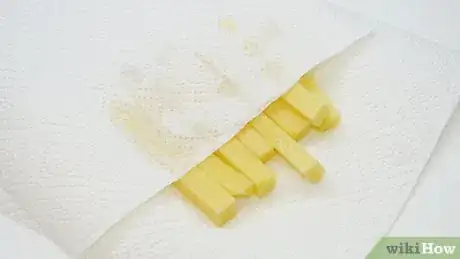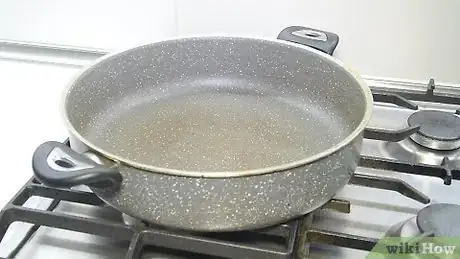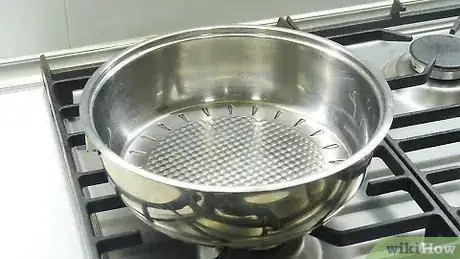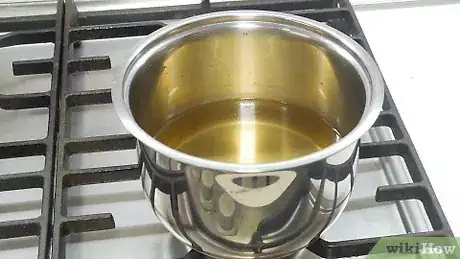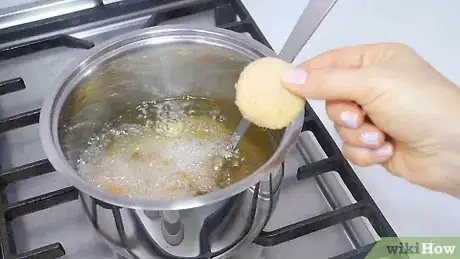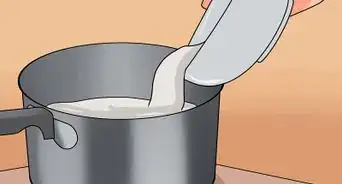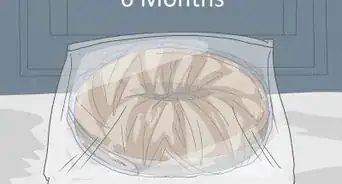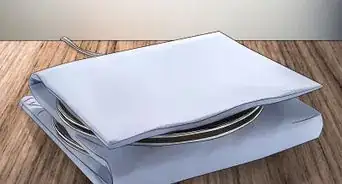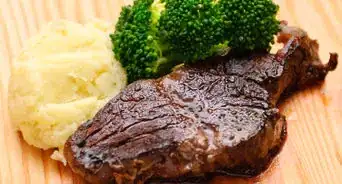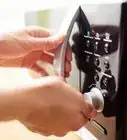This article was co-authored by wikiHow staff writer, Janice Tieperman. Janice is a professional and creative writer who has worked at wikiHow since 2019. With both a B.A. and M.A. in English from East Stroudsburg University, she has a passion for writing a wide variety of content for anyone and everyone. In her free time, you can find her working on a new crochet pattern, listening to true crime podcasts, or tackling a new creative writing project.
There are 18 references cited in this article, which can be found at the bottom of the page.
The wikiHow Culinary Team also followed the article's instructions and verified that they work.
This article has been viewed 55,725 times.
Learn more...
Fried food may taste delicious, but the oil splatter you experience along the way isn’t quite as pleasant. Believe it or not, the dreaded splattering effect typically happens when water droplets from your food touch the hot oil.[1] Not to worry—with the right cookware and some extra precautions, you can say goodbye to oil splatter once and for all!
Steps
General Frying Tips
-
1Dry off your ingredients ahead of time. As water lands in the oil and evaporates, it expands into a bunch of tiny droplets, which leads to the splattering effect we all know and dread. For extra protection, blot your ingredients dry with a paper towel or cloth before you start cooking.[2]
-
2Place a splatter shield or screen over your cooking surface. Splatter screens are perforated sections of metal that go over your pan as you cook. Vapors from your ingredients can evaporate through the openings on the screen, but the actual oil will stay put within the pan.[3]
- You can find splatter screens at most home goods stores.
Advertisement -
3
Pan-Frying
-
1Pick a tall, wide frying pan for your foods. Refrain from using shallow pans for your pan-frying recipes. Instead, grab cookware that’s big enough to fit your ingredients and also has tall sides going all around the pan. A taller pan is less likely to splatter![6]
-
2Choose high-quality stainless steel or cast iron pan. Cheap, stainless steel pans don’t always spread heat evenly—this can create hot spots on your pan, which leads to extra splattering. Instead, grab high-quality stainless steel or cast iron pan, which has decent heat distribution.[7]
- When heated up slowly, cast iron cookware has good heat distribution.[8]
-
3Add a pinch of salt to the bottom of the pan. After pouring oil into your pan, sprinkle a few pinches of salt on top. The salt helps prevent the oil from spraying around as you cook.[9]
- Salt soaks up some of the moisture in your food, which helps prevent oil splatter. You can also use flour for this![10]
-
4
-
5Cut meat into thin slices before frying it. Thinner cuts of meat are less likely to splatter. If you’re working with a thicker piece of meat, sear it before frying.[13]
- You can cut the meat into thin strips, or compress it with a mallet.
Deep-Frying
-
1Pick out a deep pot to cook your food. Grab a stockpot or deep fryer that’s big enough to hold your ingredients. Measure from the very top of the pot—to reduce the risk of splatter, there should be at least 4 in (10 cm) of space between the surface of the oil and the brim of the pot.[14]
- Woks are another great option if you’d like to deep fry your ingredients.
- Stainless steel, aluminium, copper, and cast iron are great cookware materials.[15]
-
2Place your food in mesh frying baskets. Then, deep-fry your ingredients by slowly and carefully submerging the basket in the hot oil. Always put the food in the basket before frying, so no extra oil splatters over the edges.[16]
-
3Deep-fry your food twice to prevent extra splattering. Set your frying oil to 300 °F (149 °C), and let your ingredients fry until they’re golden brown. Then, remove the cooked ingredients and pat them dry with a paper towel. Reheat the oil so it’s 350 °F (177 °C), and cook the food until it looks nice and crispy.[19]
-
4Avoid adding extra food to the frying basket. Let your first batch of food cook all the way through. If you add extra ingredients while your original food is still cooking, you could get burned by oil droplets splashing up.[20]
Warnings
References
- ↑ https://www.bonappetit.com/story/frying-mistakes-and-how-to-avoid-them
- ↑ https://homemaderecipes.com/oil-spatters-prevention/
- ↑ https://www.youtube.com/watch?v=3x5OdiQEOq8&t=2m18s
- ↑ https://www.bonappetit.com/story/frying-mistakes-and-how-to-avoid-them
- ↑ https://blog.wolfgourmet.com/how-to-pan-fry/
- ↑ https://homemaderecipes.com/oil-spatters-prevention/
- ↑ https://www.youtube.com/watch?v=3x5OdiQEOq8&t=0m50s
- ↑ https://www.youtube.com/watch?v=3x5OdiQEOq8&t=1m28s
- ↑ https://www.cnet.com/pictures/surprising-uses-for-salt/11/
- ↑ http://worldwide.borges.es/blogpost/tip-avoid-splattering-oil/
- ↑ https://homemaderecipes.com/oil-spatters-prevention/
- ↑ https://blog.wolfgourmet.com/how-to-pan-fry/
- ↑ https://www.youtube.com/watch?v=3x5OdiQEOq8&t=2m1s
- ↑ https://www.allrecipes.com/article/deep-frying/
- ↑ https://www.thekitchn.com/a-guide-to-the-best-material-for-pots-and-pans-pros-cons-168241
- ↑ https://frymax.co.uk/frying-tips/how-to-prevent-oil-splatter-when-deep-frying/
- ↑ https://www.bonappetit.com/story/frying-mistakes-and-how-to-avoid-them
- ↑ https://www.delish.com/cooking/tips/g172/frying-how-to/
- ↑ https://homemaderecipes.com/oil-spatters-prevention/
- ↑ https://www.fsis.usda.gov/wps/portal/fsis/topics/food-safety-education/get-answers/food-safety-fact-sheets/safe-food-handling/deep-fat-frying-and-food-safety
- ↑ https://m.youtube.com/watch?v=3x5OdiQEOq8&t=0m39s
- ↑ https://foodandnutrition.org/may-june-2017/kitchen-kersplat-tips-reduce-splatter/
- ↑ https://www.cooksillustrated.com/how_tos/6520-deep-frying-101-treating-your-oil-right
- ↑ https://www.cookinglight.com/cooking-101/techniques/cooking-class-pan-frying
